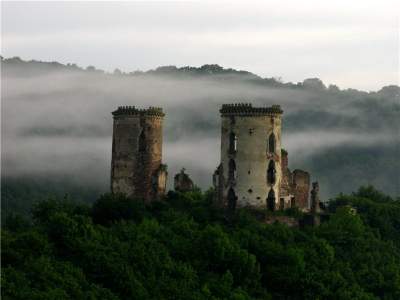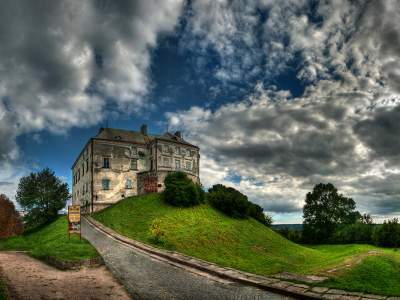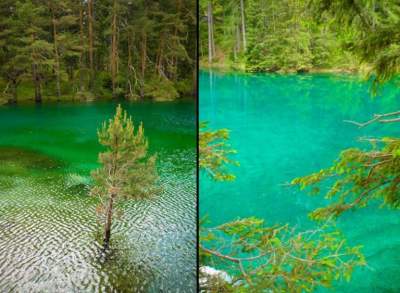 They perfectly reflect the rich history of our country.
They perfectly reflect the rich history of our country.
Locks still thrill the majority of the population. These beautiful majestic buildings reminiscent of the era of courageous knights and beautiful ladies.
Ukraine is one of the few countries that can boast with the colorful locks. Not all of them are in perfect condition, but this does not mean that they should not see with your own eyes.
Chervonograd castle in Ternopil region
The place for the settlement was chosen in a beautiful area of Podolsk intermountain. Here the river Dzhuryn river (left tributary of the Dniester river) flows in a valley surrounded by wooded hills. Leaking in the valley, the river its channel forms almost a closed loop. In the center of this “loop” rises a high hill. The river served as a natural protection for the castle hill, as the direction, the envelope hill on three sides, creating a serious obstacle to the enemy.
Now this valley, towering in the centre of castle hill is called “the tract cervone”. There is no settlement and because the castle is often referred to Nihoreni, Nyrkova two villages near the valley. But it was not always so. Once in the valley (between the villages Nyrkiv and Nahoryany) is there Chervonograd which were the fortifications on the castle hill. Later the town became a village, the village, in the farm, and eventually the farm was abolished, and the territory of the disappeared Chervonograd moved Nyrkova.

The remains of the castle in Kudryntsi, Ternopil oblast
Two centuries ago on the Zbruch was the border between the two empires – Russian and Austrian. In fact, this section has been preserved until now. Themselves Kudryntsi are mentioned in different sources since XV century and early XVI centuries is a city in the Podolian Voivodeship of the Kingdom of Poland.
In the early 17th century Kudryntsi belonged to a nobleman herburt coat of arms, which laid the castle on the banks of Zbruch. The location was not chosen by chance – a great place ensured the dominant position of the castle over the village, and allowed long withstand the attacks of the enemy.
The fortress was built of Sandstone in the shape of an irregular quadrilateral because it belongs to the type of “unilateral fortresses”. This concept is applicable to the fortress, because on three sides it is protected by a naturally – high vertical walls, the fourth side – the powerful five-foot walls, reinforced by two towers, artificial ditch and rampart.
During the entire XVII century, the fortress defended the local people against the attacks of Tartars, but against strong armies to survive it was hard for her. For example, during the wars of Poland, by Bohdan Khmelnytsky, Polish soldiers took it without a fight, and in 1672 and 1694 years it was taken by the Turks. In 1648 the fortress was taken and Maxim Krivonos at the head of peasant armies.
In the early XVIII century Golenetskii, in possession of which passed the fortress, satisfied with its rebuilding, and with the inner side of the Eastern wall appears residential building, which, in fact, live the owners of the castle. Later, after Gumenetska, tycoons Koserowski gave Kudryntsi its coat of arms in a red field a silver goat on a green base. With this emblem, usually associated village from the connoisseurs of heraldry. The new owners are starting to take to the castle works of art, Antiques, restored the castle itself. Some of the exhibits from the castle can now be found in the Museum of Ternopil. But in the XIX century begins the decay of the castle.

Svirzh castle in Lviv region
It is a unique monument of defensive architecture was built in XV—XVII centuries. Originally built as a fortress, but after the reconstruction in the seventeenth century, lost its original form. Svirzh castle is found in the archival documents from the XVI century (1530), when it belonged to gentry family of Svirzhsky. The castle was bought from the mid-seventeenth century, from the time of its transition in the property of count A. Zetner (the name given the area of the city — Teterevka and Botanical garden in Lviv). By order of the count, the castle was rebuilt and greatly strengthened.
It is assumed that the intent of Cetera to strengthen Svirzhsky castle has a well known fortifier, General of artillery Paul Grodzicki. The rebuilding of the castle was carried out around the same time, when General Grodzicki built in Lviv just two Arsenal — Royal and Senyavsky.
Despite his best defensive location, the castle is located on mount Belz and was surrounded by impassable swamps, lakes, close to the walls with moats and a drawbridge, the Palace type of architecture could hardly have serious defensive value. It is known that during the Ukrainian-Polish war in 1648-1654 the castle once took Cossack troops, and in 1648 — was burned by the Tatars.
In 1672, during the campaign of the Turks against the lions, the castle still survived the Turkish siege. During the second campaign the Turks Svirzh castle again survived and protected within its walls residents Pomoryansky castle, having sufficient power for defense, through a secret passage out into the forest and went in Svirzh.
The castle Park is a preserved Church, founded in the XV century. Modern Church building in the Renaissance style, built on the site of a wooden built in 1541. Above the entrance to the Church and today you can see remnants of nobility (coat of arms of the former owners. To the Church from the castle led underground passage. Littered part of the underground passage can be seen from the moat that surrounds the castle, near the drawbridge.
According to the testimony of the Lviv historian. Gronsky in 1956 in the Church about Svirzh castle in Svirzh, there is another Church) were visible within the murals, which opened as a result of peeling of plaster. The frescoes depicted a Nude female figure with long flowing hair in prayer on his knees by the panorama of the medieval Svarga. Judging by the description, it could be Mary of Egypt. The fate of these murals is unknown.
The current state of the castle today leaves much to be desired. In fact, preserved only the external walls. Changed the layout of the rooms of the castle, rebuilt other areas. In the courtyard you can see a large well, the water from which taken in case of siege. Today the well is abandoned.

Castle Schönborn, Transcarpathia
In a beautiful area at the foot of the mountain behind a high wrought-iron fence and the green shade of spreading trees lies one of the most precious treasures of the coast – the castle of count Schonborn, built in the late XIX century. This majestic and romantic attraction for more than a century attracts the attention of all guests.
Tall and slender building with a peaked tower gives the impression of a real medieval castle is the jewel of the city and its pride. Owned Berehove from the XVIII century Sanborni always chose for their residences only the best land and broke around the estates magnificent parks. Was no exception and the castle in the old Hungarian town. It was built for the ages: high strong walls, looking to the sky romantic tower – all in the best traditions of castle building with fabulous pictures. The schönborn castle was the summer residence of the kind here, the aristocracy came to relax, hunt, organized receptions and balls, but the twentieth century brought about changes in his fate.
In 1913 it was placed winery, which became in 1920 the property of the Czechoslovak Union of winemakers, and in 1954 the castle “reclassified” in Berehove winery. However, this period in the history of the castle Schonborn was very significant: it produced excellent wines, famous throughout the Union and made famous plant and the historic building: “Troyanda Transcarpathia”, “Promenite”, “Berehovo”. Today, for unknown reasons, the plant has virtually ceased production, and access to the castle is closed.
The beauty and splendor of the sights of Transcarpathia is definitely worthy of everyone’s attention. Now schönborn castle to admire only from afar, but even so, it produces the clearest impression.

The remains of the castle in Kremenets, Ternopil oblast
Kremenets is located in the North of Ternopil region, is a small picturesque town on the slopes of the Kremenets mountains. The most impressive thing about it is the view from the Castle hill.
The first mention of the city belong to the XIII century, when it was part of the Galicia-Volyn Principality. Next was solid, the Tatar-Mongols, who with varying success, besieged the city. In the XIV century the city became part of Lithuania in the XVI and his owner was the wife of the Polish king Bon. By then immodest, but a nice custom castle mountain was named as mount Bona.
Now, the castle remained a little – a couple of towers so the remnants of walls. Destroyed it long ago, back in 1648, during another conquest. But, despite the fact that from the castle little remains, felt that the place has preserved the spirit and aura.

The remains of the castle in Serednje, Transcarpathia
Serednie became famous and became one of the historically significant places in Ukraine thanks to the preserved ruins of the medieval castle of the knights Templar. The researchers argue that it is the only castle in Transcarpathia, where the most intact remaining elements of the Romanesque style.
The castle on the site of the modern Middle village was built in the XIII century by representatives of the knights Templar – the most powerful order in Western Europe. In 1312, after the dissolution of the order, the castle passed to the monks of the order of St. Paul.
After coming to the throne, the Hungarian king Charles Robert had held land redistribution between magnate clans. The territory where is located Sredzinski medieval castle, claimed birth Palace and Drugets. The struggle between the clans lasted for nearly a century, and as a result the interlock in the middle got Palace. After the death of the last representative of the genus Palace in 1526 Secondary along with the knight’s castle becomes the property of the genus of the Slovak gentry Dobo.
XVII – XVIIIth century – the period of constant wars between the Hungarian Kingdom on the one hand, with the Ottoman Empire, and on the other Austrian. The Average repeatedly changed owners, and the castle was gradually falling into decay. Especially large-scale damage was caused to the castle during the anti-Habsburg protrusions of the Hungarian nobility led by Ferenc Rakoczi II in 1703 – 1711.
Today the medieval castle of the knights Templar in Average serves as a valuable example of the early fortifications of the middle ages.
A distinctive feature of medieval feudal castles is the presence of a donjon – the main tower in the courtyard. Sretenskogo donjon of the castle is rectangular in plan, three-tiered tower with a height of 20 m and a thickness of walls – more than 2.5. The entrance to the donjon was located in the center of the East wall on the second layer, and led him to the wooden stairs that could be quickly destroyed in case of danger. On the first floor of the donjon there were 2 spaces, covered by cylindrical vaults. In one of these buildings housed a white stone spiral staircase leading to the second floor, and from there another staircase led to the third. On the first tier, discovered a hole, stoned, which gives grounds to assume that it was previously well. Due to insufficient illumination of the first tier here, most likely, was the storage rooms, Arsenal and prison.
Sredzinski Templar castle was protected by two defense lines. The extension consisted of a stone wall with 4 towers around the castle courtyard and also a double circle of walls and ditches filled with water. External wooden line of defense was a number of dead oak trunks, the so-called “Palanok”. Till our days these defensive lines only preserved remains of walls and ditches.
An important role in the defensive system of the knights ‘ castle played Western and southern walls of which are well overlooked the entrance to the courtyard of the castle. Within these walls, respectively, carried out the largest number of Windows, loopholes.
The medieval castle in Average repeatedly became the place of battles and changed its owners. For centuries he had a significant injury to eliminate that there was no hurry. In 1972 in Sretenskom the castle was carried out conservation works.

Olesko castle, Lviv oblast
Olesky castle is the oldest castle in Western Ukraine and one of the most famous castles of Lviv, which is located in the village of Olesko in Lviv region. The walls of this castle has survived many battles and wars, since there was intense fighting between the Lithuanian and the Polish Kingdom for possession over him. The castle was restored from a complete ruin and now, after the restoration, he plays the role of the Museum, which contains exhibits of medieval art.
The official name of the Castle Danilovich. The first written reminiscence about this castle is dated 1327. In Polish history Olesko castle is known to be the birthplace of the most glorious king of Poland Jan III Sobieski.
After frequent attacks of the Tatars, the building of the Olesky castle was ruled by magnates sort of Danilovich, where he served as the father of Bohdan Khmelnytsky. The head of this kind is taken for the reconstruction of the castle, and after it played there for his daughter’s wedding. In 1627 the castle was rescued by the troops of Bohdan Khmelnytsky, and in 1682 the castle was bought by king Jan III Sobieski. The restoration of the castle and parkland carried out by his wife, Mary, who became the heiress of the castle after the death of Jan.
In the twentieth century an earthquake occurred, which mercilessly affect the state of the lock, and turned it into ruins. Already in 1970 the idea of one more restoration and rebuilding was proposed by the head of architecture A. Solara in the period 1970-1974 it was implemented. By its end in 1975, renovated Olesko castle was presented as a Museum, which is still a branch of Lviv art gallery.
The castle building consists of two semi-oval two-storey buildings, whose walls are built of stone and bricks. Around the Museum there is a very beautiful Park, which has modern sculptures and planted a variety, which makes the Park area unique and beautiful.
You should pay attention to the Capuchin monastery, which stands opposite the castle. In the dungeons of the monastery was carried out burial of the monks, and was there buried, and Severin Rzewuski Anna and their four children. Severin Rzewuski was a well-known Polish magnate, one of the owners of Olesko castle and founder of the Capuchin monastery.

Kamianets-Podilskyi castle
The castle supposedly existed in the times of Kievan Rus, but a stone castle built by the Lithuanian princes Koriatovichi. From 1362 to 1434, the fortress in the complex with defense buildings of the city became the main Outpost of Lithuania, and from 1434 to 1793 — the Polish government Podolia, and played a significant role in repelling the Turkish-Tatar campaign in the West.
Fortress Kamenetz-Podilskyi was first mentioned in 1374 in the Charter of Prince Yury Koriatovich (one of 4 brothers koriatovich who owned a Hem). At that time the towers and walls had been of stone and partly of wood. The fortress was at the entrance to the city, which led to a narrow 9-metre isthmus, and was his reliable protection (the city was located in the loop of the river Smotrych). That’s when Koriatovichi the city became the capital of the region (and fiefdoms), and the fortress — a strategic defence point.
In the XV century the region was captured by the poles. Polish princes Bucaccia lured the Lithuanian Governor Daugirda on negotiations and, by imprisoning him, seized Kamenets fortress and the control of the city. Later they sold him to the king, and Kamenetz-Podolsk became the center of the province, an important border Outpost of the defence of the Commonwealth, “extreme Bastion of Christianity.” On the inventory of 1492, the castle consisted of towers and stone walls with two gates on the South and North. Adjacent to the castle yard was surrounded by a wooden wall near it “stands”. In the middle of the XVI century wooden fortifications of the fortress under the supervision of architect job Breitfus were replaced with stone. Since that time, the castle acquired its modern look. The fortress is elongated polygon. It is surrounded by high walls with towers at each corner. To the left of the East gate is the Papal tower, her Cap, Tychynska tower, tower No. 8 Lacka, Day tower, New West tower, West Small tower, Rozhanka, curfew tower, tower Lanckoronska, the Black tower (basement), New East. Near the river is the tower of Water.
In 1672 the town of Kamyanets-Podilsky was captured by the Turkish army. Since then, the castle bridge was called “Turkish”. At the end of the XVII century the castle returned to Poland, and later in the division of Commonwealth — was ceded to the Russian Empire. In the nineteenth century, the Kamianets-Podilskyi castle had lost its military significance. In 1928, the fortress became a Republican reserve, and in 1937 it was organized by the Museum-reserve. At the moment, with Cathedral and city hall are among the main attractions of the city.
2 Aug 2011 due to adverse weather conditions a New West tower was partially destroyed.

Belgorod-Dniester castle, Odessa oblast
Well-preserved Belgorod-Dnestrovskiy fortress is the largest in Ukraine. The oldest part of the Citadel – was built by the Genoese in the XIII century on the steep Bank of the Dniester estuary on the site of the ancient city-state of Thera.
It in 502 BC, was founded by colonists from the Greek city of Miletus. Then it was owned by Goths, Huns, Slavs (founded Belgorod), and in the XIII century was captured by the Genoese, who for the protection of trade routes built the castle-fortress.
Genoese castle (Citadel) consisted of four tiled round towers, connected by walls with a thickness up to 5 m. Along them in three tiers held the wooden fighting gallery. The great tower – street. In it, in 1789, the Turks handed over the keys to the castle of M. Kutuzov. In 1790 he became its commandant.

Castle in Dubno, Rivne oblast
Dubno castle in Dubno, Rivne region built by Prince Janusz ostrogski in the middle of the XVII century in late Renaissance style based on previously built fortifications 1492 he is considered one of the oldest castles of Ukraine with an extensive system of underground tunnels, which hid local residents during the attacks of outsiders. The territory of the location of the castle is the best in the strategic plan, as protected by the river Ikva and swampy valley, the castle belongs to the fortifications of the Bastion type. Two mighty bastions with the casemates are from the city and separated from it by a deep moat. At the corners of the bastions are small towers cavalier, in particular Beatka tower, or Maiden’s tower. In the thickness of the bastions built underground passages, the casemates, one of which is arranged a Museum exhibition. Entrance to the castle was provided through the bridge and gate, which gate is arranged in the housing.
On the territory of the fortress are two of the Palace: the South side is the Palace of the princes of Ostrog, and to the North is a two – storey Palace of the princes Lubomirski, which was built in the late XVIII century with the use of Foundation walls and outbuildings. At the Western wall are the premises of the barracks.
In the XIX century the castle went through tough times of constant restructuring and decline has led to significant destruction and changes to the original decor. During the First world war the Austro-Hungarian troops partially destroyed fortification. In the 30-ies of XX century the castle was in ruins, so in 1934 the poles were forced to rebuild it again. Till our days survived only the white stone portal of the entrance gate of the castle, which was built in the mid-seventeenth century, attesting to its Renaissance past. With the 50-ies of XX century there was a dislocation of the military unit, which existed in the castle until 1986 In 1993, after the proclamation of Ukraine’s Independence, the castle became part of the State historical and cultural reserve of Dubno.
In 1999, created the Charitable Foundation of the revival of Dubno castle, which contributed to the restoration and development of historical and cultural complex of castle buildings. Thanks to the Fund, was carried out repair-restoration works of watchtowers and opened a shop where tourists, visitors and all interested persons have opportunity to buy Souvenirs, historical essays and works of art dedicated to the glorious past.
Today Dubno castle (the Castle of princes of Ostrog) in the city of Dubno is gradually recovering and coming back to life, there is a Museum, open a variety of exhibitions, it is rare in its beauty and uniqueness fortification that belongs to outstanding monuments of culture, history and military architecture.









